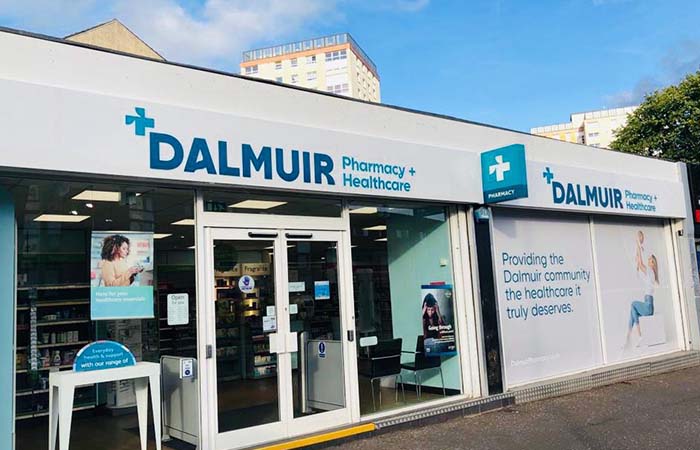Pharmacy Connect: How are tech providers responding to new services?
In News
Follow this topic
Bookmark
Record learning outcomes
With Pharmacy First driving forward the case for more joined‑up digital records access for community pharmacy, how are tech suppliers and contractors navigating this evolving technological landscape? Saša Janković reports
After years of lobbying, England’s community pharmacy network is finally getting read-write access to patient records to support services like Pharmacy First.
For starters, there’s GP Connect Update Record – one of the enhancements to connect community pharmacy and general practice announced in the NHS England delivery plan for recovering access to primary care in May 2023.
This is available in four pharmacy patient medication record systems: Positive Solutions, Cegedim Healthcare Solutions, Sonar Informatics and EMIS Health Community Pharmacy.
The system allows authorised clinicians in community pharmacy to send pharmacy consultation summaries following Pharmacy First, blood pressure check and contraception services consultations – including details of any medicines supplied – directly into general practice workflows for filing, rather than via NHS mail or letter.
This reduces practice burden and increases patient safety, by removing the need to manually transcribe consultation summaries and supplied medicine details from emails or letters into the GP patient record.
It began with a small number of GP practices and community pharmacies in January 2024, before IT suppliers began to roll it out across all practices at the start of April.
There was a blip in July when GPs realised that the option for practices to turn off Update Record, while they got used to the new system, was only temporary, led to GP representative bodies encouraging them to turn it off.
This resulted in NHS England (NHSE) reassessing, and confirming that the ability for a practice to opt out of Update Record would not change, and that opting out would remain an option for practices.
Nonetheless, the latest figures from NHSE show that as of 8 July, more than 5,660 community pharmacies had sent 110,000 consultation summaries to GP practices using Update Record, with suggestions of a future expansion of the system to include updates for urgent medicine supplies.
The London view
In a more localised setting, several community pharmacies in South East London have recently joined pharmacies in North East London Integrated Care Systems (ICS) and South West London ICS in being given access to the London Care Record. This is based on a product called the Health Information Exchange (or HIE) from Cerner UK.
A central OneLondon Health Information Exchange is connected to a series of local Health Information Exchanges (HIEs) enabling a ‘single and secure’ view of patient data to be accessed and shared by primary, secondary and community care providers across London and surrounding areas.
Data on the London Care Record includes a patient’s contact details, medication and test results, appointment and referrals information. Pharmacies can currently only have access to the information, but cannot share it.
Booking and Referral Standard
Next in line for pharmacy access looks to be the Booking and Referral Standard (BaRS) that facilitates digital patient journeys or operational processes for patients, healthcare workers and carers.
Deemed by NHSE to be a “crucial part of digital transformation policy across the NHS”, BaRS allows relevant information to be shared quickly and safely between NHS 111/clinical assessment services (CAS) and emergency departments (EDs), urgent treatment centres (UTC) and same day emergency care (SDEC); between NHS 111 Online and EDs and UTCs; between Streaming and Redirection and EDs and UTCs; between 999 and CAS for referral; and between 999 and CAS for ambulance validation.
NHSE says patient journeys between general practice and pharmacy are currently in development or testing, with “many more journeys on the roadmap for BaRS over the next 12-24 months”, with the aim that it “will eventually be available in all care settings”.
Tech enablers
While all these interconnected system may be the strongest indicator yet that the move towards services is fundamentally aligned with technological capabilities, this is a trend that has been coming for years.
Many contractors have been investing in automation and prescription collection kiosks for some time, and recent developments in the patient medication record (PMR) industry offer more dynamic solutions for prescription management, preparing pharmacists to have a fuller clinical management role in patient care.
“The role of pharmacists in the community has been evolving, now more so than ever with the introduction of the Pharmacy First scheme, which helps to position pharmacies as key providers of urgent care, meeting the growing needs of patients, while supporting the over-stretched NHS,” says Edward Platt, senior commercial director of Omnicell’s UK community pharmacy division, in addition to Omnicell’s UK & Ireland hospital division.
However, despite this shift enabling pharmacists to provide a greater focus on patient health and wellbeing, in many instances allowing them to be more accessible than some local GPs for many common health issues, current challenges such as drug shortages and staff recruitment problems have taken the shine off Pharmacy First.
In fact, a recent Omnicell survey among pharmacists found that a ‘lack of time’ was a key reason that over half are currently unable to fully benefit from the new Pharmacy First initiative, with three quarters citing ‘staff workload’ as one of their biggest challenges.
“This is where pharmacy technology and automation can play a crucial role,” says Platt. “Technology alleviates the burden of ordering and managing stock or completing mundane tasks, allowing pharmacists to dedicate and direct more time to face-to-face patient care and additional revenue streams.
"In the UK today, for example, our network of 200 Pharmaself24 machines is successfully delivering over 150,000 medications to patients per month, which equates to 1.8 million collections every year, and our VBM-200F MDS pack-fill-and-check robots produce over 200,000 medication blister trays every month – 2.4 million per year - for pharmacy customers. This enables pharmacists to spend more time with patients, while enhancing patient safety by reducing medication errors.”
Positive Solutions is one of just three PMR providers selected to work with NHS England in developing the architecture to support its Primary Care Access Recovery Plan (PCARP), and with a role in getting both BaRS and GP Connect to market. Steve Russell, its chief commercial officer, says the good PMR systems are already doing much more than just labelling boxes of medication.
“Their functionality increasingly mirrors that of clinical management systems and will only become more so as we prepare for the arrival of independent prescribing for all,” he says. “The future of PMR is as the centre point of a much bigger pharmacy technology ecosystem.
"That’s why ‘Beyond PMR’ has become something of a strapline for us with our Hx software portfolio, which encompasses patient relationship management (through our MyHealthHub app), business management tools and reports (HxIntel) and a care home eMAR solution (HxCare) alongside HxConsult as our innovative services platform.”
Dispensing discussions
Dispensing is long past the days of being a successful manually driven process, or a pharmacy’s core source of income. Phil Galt, former superintendent pharmacist and now managing director of Cegedim Rx, believes that technology needs to not only “shoulder more of the process-based burden by automating more of the dispensing journey” but also provide pharmacy teams with “nudges” towards greater opportunities for more profitable services.
“Our systems are always evolving, but some recent additions and enhancements that are making a big impact within prescription management are features that add more automation into the process, such as automated clinical checking,”explains Galt.
“Our customer, the Saffron Group, has benefited from this already, with more than 50 per cent of prescriptions now going through the Pharmacy Manager Automated Clinical Check process, resulting in a huge time saving for the pharmacist.
"We’re currently underway with a host of customer pilots for new - soon to be launched - services such as Scan to Shelf functionality that will drive further pharmacy efficiencies with bag location and patient handout.”
Discussion about transforming the dispensing journey also cannot ignore the prospect of hub and spoke, assuming the announced legislation change by the former government gets rubber-stamped to go ahead as planned in the new year. “Hub and spoke will make a huge impact, especially on independents.” says Galt.
“It’s something we’ve been readying ourselves for and investing in. This year has been especially big for us in helping more pharmacy groups use remote fulfilment to streamline the dispensing process through our Hub Fulfilment Manager. This saves time, reduces unnecessarily high stock levels and helps release much needed capacity in-pharmacy for the delivery of more profitable clinical services.”
Better relationships
So could the increasing ease of interconnectivity between healthcare settings further strengthen relationships between community pharmacies and their primary care colleagues?
Dr Satya Raghuvanshi, VP of Clinical for the healthcare communications provider Accurx, believes that excellent care is based on the ability to communicate quickly and effectively across structures and systems.
“Clunky tech, lack of system integration and fragmented channels are continuing to delay pharmacists from resolving patient needs quickly and appropriately,” she says.
“Pharmacies need better ways to communicate bidirectionally with their colleagues in GP and trusts. Solutions – such as Accurx – focused on breaking down communication barriers are going to be crucial to the continued integration of pharmacy with the wider health system. “
And, of course, more joined-up communication also positions the patient at the centre of their care. Santosh Sahu, founder and CEO of pharmacy tech platform Charac, says if the NHS works alongside suppliers to enable them to link with simple Application Programming Interfaces this will “create a more integrated healthcare system which will allow pharmacists to access the tools to push and pull patient information when they require it, and ensure patients are always at the centre of the care they provide”.
Now is the time for community pharmacists to shine. “GPs have, historically, been regarded, and regarded themselves, as the custodian of the patient primary healthcare record and, as evidenced in the recent BMA justification for encouraging their members to switch off GP Connect, they’ve been highly protective about that role,”says Positive Solutions’ Russell.
“While the ultimate aim has to be to put the patient at the centre of all their clinical records, that is likely to be a much longer-term objective given the dependency on NHS/government action to achieve this.
"In the interim, we remain hopeful that, as pharmacies take on an increasing volume of patient consultations and, perhaps more importantly, GPs start to recognise the huge benefits to them and their patients of sharing the clinical load with highly skilled pharmacists, the linkages to the two will improve even further.”
Case study: Dalmuir Pharmacy dials up the digital
Dalmuir Pharmacy is a newly established, family-owned, independent pharmacy located in Dalmuir, Scotland. Recognising a growing need for more digitally enhanced ways to run the pharmacy, owner Tony O’Reilly adopted Positive Solutions’ Analyst IPS when the pharmacy opened. He wanted a simple-to-use technology solution across PMR and EPoS that could integrate with other systems and was backed by the promise of continuous development.
While this was a great first step for the pharmacy, Tony knew that customers still had to pick up the phone or stop by the pharmacy to find out when their prescription was ready. “We needed a better solution to improve this experience and meet the growing demand for a digitally focused pharmacy,” says Tony. “The next step was to implement the MyHealthHub patient app, which integrates within the same technology ecosystem.”
MyHealthHub links into Analyst PMR and enables independent high street pharmacies to compete with larger, online pharmacies by providing them with a direct link to their patients to enable easy prescription ordering and tracked home deliveries.It cuts out the wait for GPs by booking appointments for both NHS and private services via the app.
“MyHealthHub immediately enabled my customers to order their prescriptions in a way that was much better than GP apps or via telephone,” explains Tony. “Adopting the app was a natural step for us, aligning perfectly with our goal to future-proof our pharmacy and enhance our online presence. Patients appreciate the control and visibility MyHealthHub provides over their prescription journey. They no longer need to visit or call the pharmacy as everything can be managed through the app.”
As well as enhancing patient relationships, Tony says the integration between Analyst IPS and MyHealthHub has “optimised operations internally, not only improving efficiency but also giving us more time to deliver personalised patient care”.



